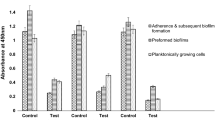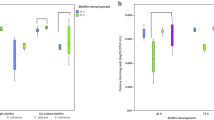Abstract
Candida albicans has the ability to colonize various materials used in prostheses. In this report, we have studied the kinetics of biofilm formation on prosthetic materials and their susceptibility to fluconazole at various stages of development. Results indicated that C. albicans efficiently adheres to and colonizes polystyrene, polyvinylchloride, silicon, and polycarbonate surfaces. Candida albicans biofilm formation was observed to be both strain- and substrate dependent. Adhesion of cells to solid substrates was found sufficient to induce fluconazole resistance. Drug susceptibility at different stages of biofilm growth showed that Candida biofilms on these substrates are highly resistant to fluconazole. The study focuses on the limitations of fluconazole to combat biofilm-related infections and emphasizes the need for better therapeutic strategies against prosthesis-associated C. albicans infections.





Similar content being viewed by others
References
Andes D, Nett J, Oschel P, Albert R, Marchillo K, Pitula A (2004) Development and characterization of an in vivo central venous catheter Candida albicans biofilm model. Infect Immun 72:6023–6031
Baillie GS, Douglas LJ (2000) Matrix polymers of Candida albicans biofilms to antifungal agents. J Antimicrob Chemother 46:397–403
Chandra J, Kuhn DM, Mukherjee PK, Hoyer LL, McCormic T, Gannoum MA (2001a) Biofilm formation by fungal pathogen Candida albicans: development, architecture and drug resistance. J Bacteriol 183:5385–5394
Chandra J, Mukherjee PK, Leidich SD, Faddoul FF, Hoyer LL, Douglas LJ, Ghannoum MA (2001b) Antifungal resistance of candidal biofilms formed on denture acrylic in vitro. J Dent Res 80:903–908
da Silva WJ, Seneviratne J, Samarnayake LP, Del Bel Cury AA (2010) Bioactivity and architecture of Candida albicans biofilms developed on poly (methyl methacrylate) resin surface. J Biomed Mater Res B Appl Biomater 94:149–156
Donlan RM, Costerton JW (2002) Biofilms: survival mechanism of clinically relevant microorganisms. Clin Microbiol Rev 15:167–193
Douglas LJ (2002) Medical importance of biofilms in Candida infections. Rev Iberoam Micol 19:139–143
Douglas LJ (2003) Candida biofilms and their role in infection. Trends Microbiol 11:30–36
El-Azizi M, Khardori N (1999) Factors influencing adherence of Candida spp. to host tissues and plastic surfaces. Indian J Exp Biol 37:941–951
Gomes PN, da Silva WJ, Pousa CC, Narvaes EAO, Del Bel Cury AA (2011) Bioactivity and cellular structure of Candida albicans and Candida glabrata biofilms grown in the presence of fluconazole. Arch Oral Biol doi:10.1016/j.archoralbio.2011.04.006
Imbert C, Lassy E, Daniault G, Jacquemin JL, Rodier MH (2003) Treatment of plastic and extracellular matrix components with chlorhexidine or benzalkonium chloride: effect on Candida albicans adherence capacity in vitro. J Antimicrob Chemother 51:281–287
Jabra-Rizk MA, Falkler WA, Meiller TF (2004) Fungal biofilms and drug resistance. Emerg Infect Dis 10:14–19
Jain N, Kohli R, Cook E, Gialanella P, Chang T, Fries BC (2007) Biofilm formation by and antifungal susceptibility of Candida isolates from urine. Appl Environ Microbiol 73:1697–1703
Jin Y, Samaranayake LP, Samaranayake Y, Yip HK (2004) Biofilm formation of Candida albicans is variably affected by saliva and dietary sugars. Arch Oral Biol 49:789–798
Khot PD, Suci PA, Miller LR, Nelson RD, Tyler BJ (2006) A small subpopulation of blastospores in Candida albicans biofilms exhibit resistance to amphotericin B associated with differential regulation of ergosterol and β-1,6-glucan pathway genes. Antimicrob Agents Chemother 50:3708–3716
Kojic EM, Darouiche RO (2004) Candida infections on medical devices. Clin Microbiol Rev 17:255–267
Kuhn DM, Chandra J, Mukherjee PK, Ghannoum MA (2002) Comparison of biofilm formation by Candida albicans and Candida parapsilosis on bioprosthetic surfaces. Infect Immun 70:878–888
Kumamoto CA (2002) Candida biofilms. Curr Opin Microbiol 5:608–611
Kumamoto CA, Vinces MD (2005) Alternative Candida albicans life styles: growth on surfaces. Annu Rev Microbiol 59:113–133
LaFleur MD, Kumamoto CA, Lewis K (2006) Candida albicans biofilms produce antifungal-tolerant persister cells. Antimicrob Agents Chemother 50:3839–3846
Lewis K (2001) Riddle of biofilm resistance. Antimicrob Agents Chemother 45:999–1007
Mukherjee PK, Chandra J, Kuhn DM, Ghannoum MA (2003) Mechanism of fluconazole resistance in Candida albicans biofilms: phase-specific role of efflux pumps and membrane sterols. Infect Immun 71:4333–4340
Nett JW, Crawford K, Marchillo K, Andes DR (2010) Role of Fks1p and matrix glucan in Candida albicans biofilm resistance to an echinocandin, pyrimidine, and polyene. Antimicrob Agents Chemother 54:3505–3508
Nikawa H, Nishimura H, Makihira S, Hamada T, Sadamori S, Samarnayake LP (2000) Effect of serum concentration on Candida biofilm formation on acrylic surfaces. Mycoses 43:139–143
Ramage G, Vande Walle K, Wickes BL, Lopez-Ribot JL (2001) Standardized method for in vitro antifungal susceptibility testing of Candida albicans biofilms. Antimicrob Agents Chemother 45:2475–2479
Ramage G, Bachmann S, Patterson TF, Wickes BL, Lopez-Ribot JL (2002) Investigation of multidrug efflux pumps in relation to fluconazole resistance in Candida albicans biofilms. J Antimicrob Chemother 49:973–980
Ramage G, Martinez JP, Lopez-Ribot JL (2006) Candida biofilms on implanted biomaterials: a clinically significant problem. FEMS Yeast Res 6:979–986
Raut J, Rathod V, Karuppayil SM (2010) Cell surface hydrophobicity and adhesion: a study on fifty clinical isolates of Candida albicans. Jpn J Med Mycol 51:131–136
Rex JH, Pfaller MA, Walsh TJ, Chaturvedi V, Espinel-Ingroff A, Ghannoum M, Gosey LL, Odds FC, Rinaldi MG, Sheehan DJ, Warnock DW (2001) Antifungal susceptibility testing: practical aspects and current challenges. Clin Microbiol Rev 14:643–658
Richter SS, Galask RP, Diekema DJ, Messer SA, Pfaller MA, Hollis RJ (2005) Antifungal susceptibilities of Candida species causing vulvovaginitis and epidemiology of recurrent cases. J Clin Microbiol 43:2155–2162
Silva WJ, Seneviratne J, Parahitiyawa N, Rosa EAR, Samarnayake LP, Del Bel Cury AA (2008) Improvement of XTT assay performance for studies involving Candida albicans biofilms. Braz Dent J 19:364–369
Soustre J, Rodierm MH, Imbert BS, Daniault G, Imbert C (2004) Caspofungin modulates in vitro adherence of Candida albicans to plastic coated with extracellular matrix proteins. J Antimicrob Chemother 53:522–525
Thein ZM, Samaranayake YH, Samaranayake LP (2007) Characteristics of dual species Candida biofilms on denture acrylic surfaces. Arch Oral Biol 52:1200–1208
Xiang L, Zhun Y, Jianping X (2004) Quantitative variation of biofilm among strains in natural population of Candida albicans. Microbiology 149:353–362
Acknowledgments
The authors acknowledge the financial assistance provided by UGC, New Delhi, India. Ref. No. F-32-549/2006(SR).
Author information
Authors and Affiliations
Corresponding author
About this article
Cite this article
Shinde, R.B., Raut, J.S. & Karuppayil, M.S. Biofilm formation by Candida albicans on various prosthetic materials and its fluconazole sensitivity: a kinetic study. Mycoscience 53, 220–226 (2012). https://doi.org/10.1007/s10267-011-0155-y
Received:
Accepted:
Published:
Issue Date:
DOI: https://doi.org/10.1007/s10267-011-0155-y




